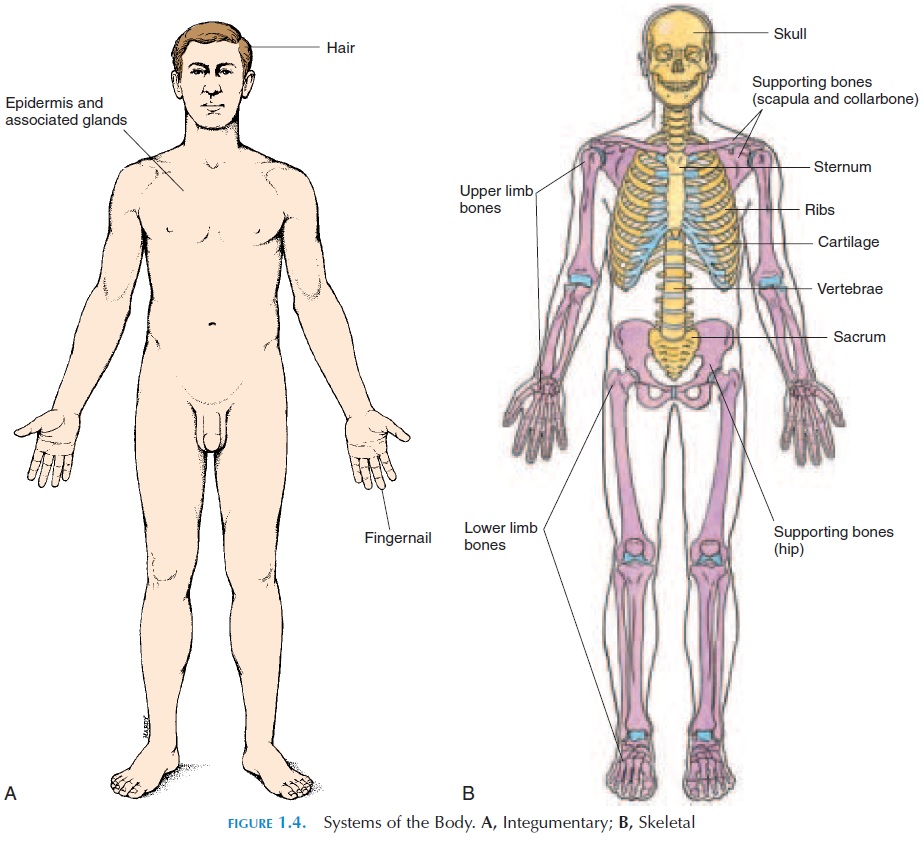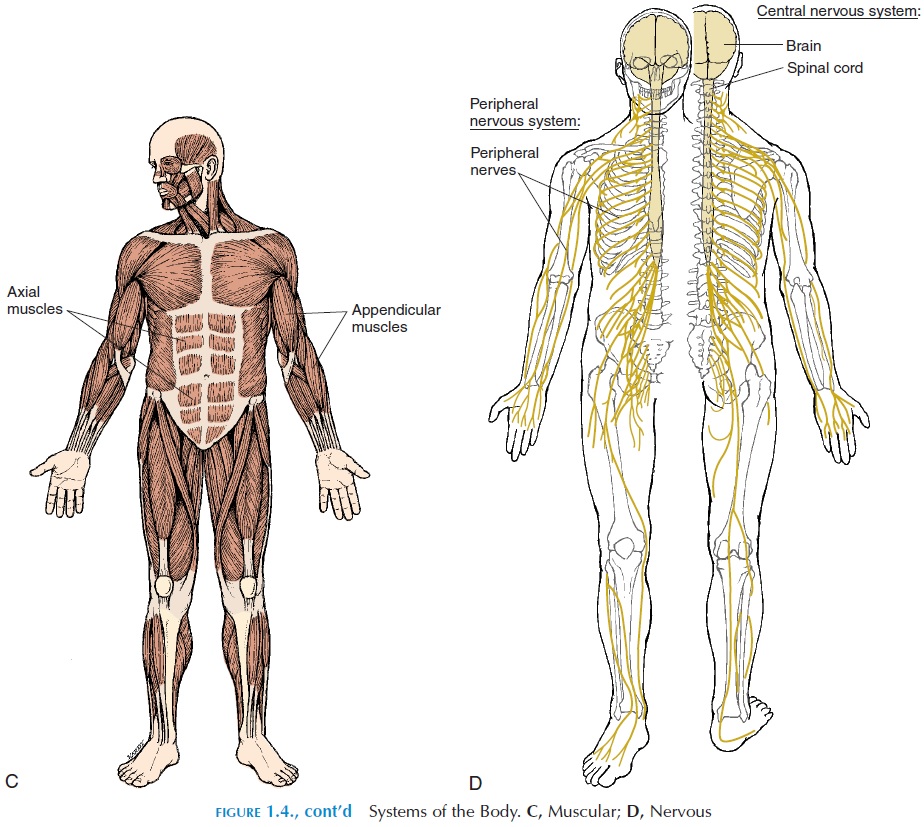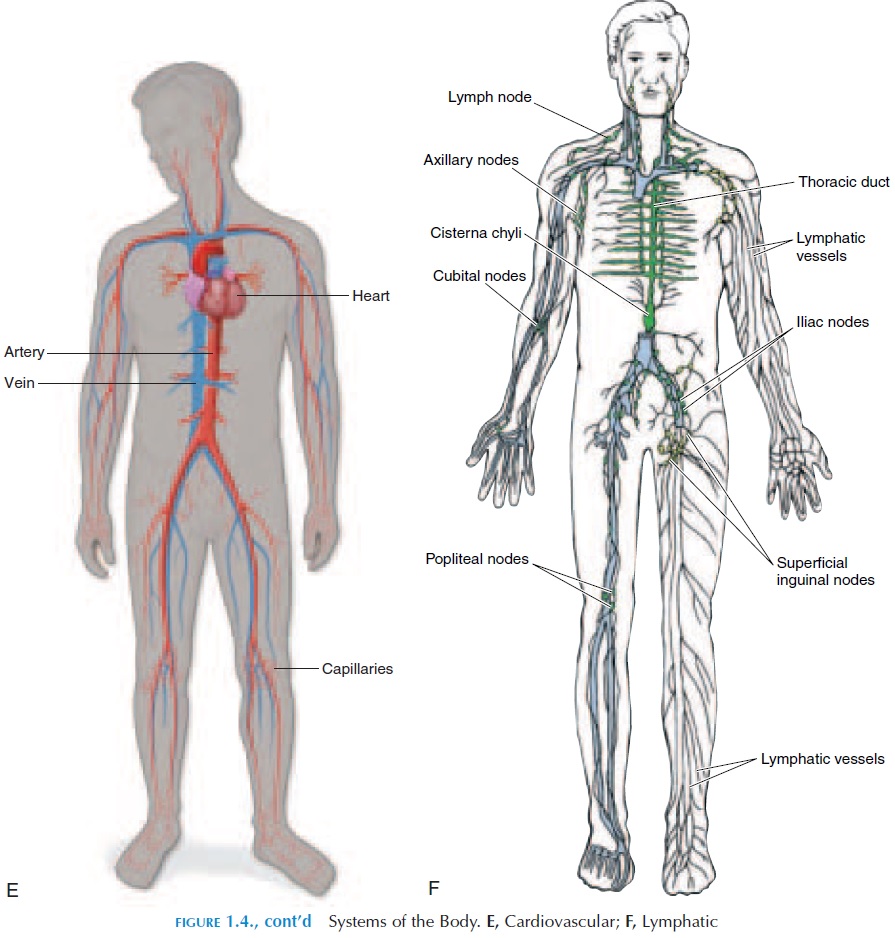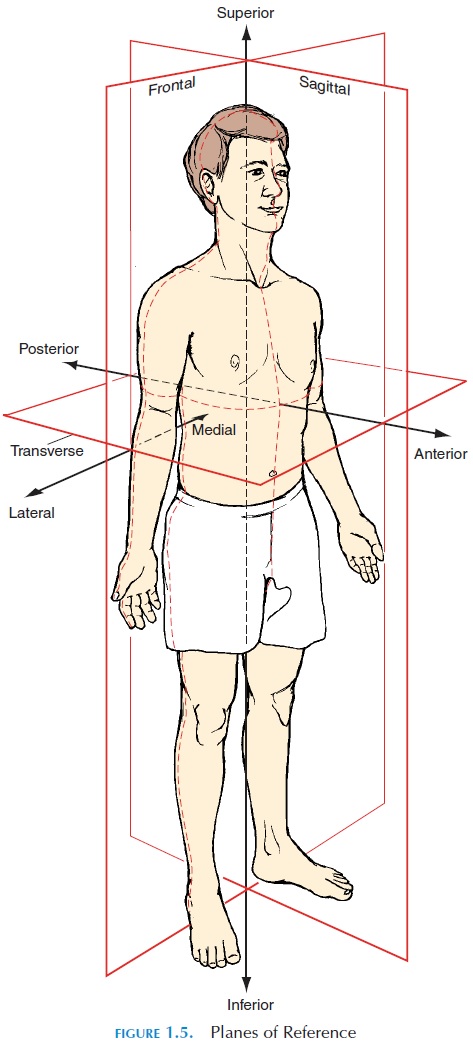Chapter: The Massage Connection ANATOMY AND PHYSIOLOGY : Introduction to Anatomy and Physiology
Systems of the Body
Systems of the Body
This book, for convenience, divides the body into the integumentary, skeletal, muscular, nervous, car-diovascular, lymphatic, respiratory, endocrine, re-productive, digestive, and urinary systems (seeFigure 1.4). At times, the skeletal and muscular are considered together as musculoskeletal system.

The integumentary (skin) system includes theskin and all of its structures, such as sweat glands, nails, and hair. The major function of this system (see Figure 1.4A) is to protect the body from environmen-tal hazards and to maintain core temperature. For an example of how skin maintains homeostasis, con-sider the effects of an increase in atmospheric temperature.
The skin possesses sensors (nerve recep-tors) that detect temperature change. When a rise in temperature is detected, the network of blood vessels in the skin, aided by the nervous system, dilate and more blood reaches closer to the surface of the body where heat can be removed by conduction. The sweat glands increase production, and the body is cooled by sweat evaporation until body temperature reaches normal values. Other skin functions include manu-facturing vitamin D and eliminating waste products.
The skeletal system (see Figure 1.4B) comprises the bones, bone marrow, and joints of the body. The skeletal system’s major functions are to support the body, provide an area for muscle attachment (bones), and allow movement in various planes (joints).
In ad-dition, this system protects tissue and organs—for ex-ample, the ribs protect the lungs and heart, which are located in the chest. Minerals, including calcium, are deposited in the bones and are mobilized when the blood levels of these minerals are lower than the nor-mal range. Different parts of the bones also manu-facture blood cells.
The muscular system (see Figure 1.4C) is respon-sible for any form of movement. It includes all the muscle tissue of the body. The skeletal, cardiac, and smooth muscle are three types of muscle tissue. This system allows the organism to move in the external environment. In addition, internal muscles help move blood inside the body (e.g., the heart). The blood volume in any region can be altered by muscle contractions, which narrow or dilate the vessel, in the blood vessels walls.
Muscles in the tube walls of the respiratory tract alter the size of the tubes. Food is moved down the gut by the contraction and relax-ation of muscles. Urine is expelled from the body by contraction of the muscles of the urinary bladder. The process of muscle contraction also produces heat and helps maintain body temperature.

The nervous system (see Figure 1.4D) consists of structures that respond to stimuli from inside and outside of the body, integrating the sensed stimuli and producing an appropriate response. Nervous sys-tem structures include the brain, the spinal cord, the nerves, and the supporting tissue. The nervous sys-tem coordinates the activities of all other organ sys-tems. For example, the nervous system senses the change in temperature when you enter a cold room and, by making the hair on your arms stand on end and your muscles shiver (rapid contraction and re-laxation), produces heat.
The organs of the cardiovascular system (see Fig-ure 1.4E) are responsible for the circulation of blood. This system includes the heart, blood vessels, and the blood. It helps transport oxygen, nutrients, and hor-mones, among others, throughout the body to vari-ous tissue, according to the needs of the tissue. Con-versely, it carries waste products from the tissue to other areas for excretion.

The lymphatic system (see Figure 1.4F) consists of lymph vessels, lymph nodes, and lymphoid tissue in such areas as the tonsils, spleen, and thymus. It is re-sponsible for defense against infection and disease and to help remove excess water from the tissue spaces.
The respiratory system (see Figure 1.4G) works closely with the cardiovascular system and includes the nose and nasal cavities and the pharynx, larynx, trachea, bronchial tubes, and lungs.
Although the res-piratory system brings oxygen to the site where ex-change can take place (i.e., between air and the blood), it is the cardiovascular system that circulates the blood and enables the tissue access to the oxygen. The respiratory system also allows carbon dioxide, a byproduct of metabolism, to be released in the air.

The endocrine system (see Figure 1.4H) works closely with the nervous system. Through the use of hormones, it produces long-term changes in var-ious organ and system activities. Hormones are the chemicals secreted by the organs of the endocrine system, which include the pituitary, thyroid, parathyroid, and adrenal glands and endocrine part of the pancreas, ovary, and testis. The blood carries these chemicals to other receptive organs and, in turn, produces change. For example, during a preg-nant woman’s labor, the hormone oxytocin is se-creted by an endocrine organ in the brain (pitu-itary) and is carried by the blood to the uterus. The uterus, in turn, responds by contracting.
The reproductive system (see Figure 1.4I) is re-sponsible for the propagation of the species and in-cludes organs, such as the ovary and testis, that man-ufacture sperms or eggs and secrete sex hormones. Other organs include the fallopian tubes and uterus in women and the vas deferens
and accessory glands in men. The hormones, together with the genetic make up, is responsible for the male or female char-acteristics of the body.

The digestive system (see Figure 1.4J) also works in coordination with the cardiovascular system. Re-sponsible for breaking down food into a form that can be used by the body, the cardiovascular system carries the nutrients to the needed tissue. The diges-tive system includes the mouth, pharynx, esophagus, stomach, and small and large intestines.
The urinary system (see Figure 1.4K) eliminates excess water, salts, and waste products. When the body is dehydrated, this system helps conserve water and salt. In addition, together with the respiratory system, the urinary system maintains the body fluid pH. Its structures include the kidney, ureter, urinary bladder, and urethra.

Related Topics